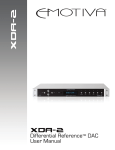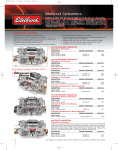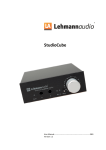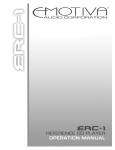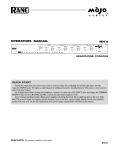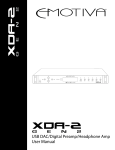Download Audio Note QUEST Silver Signature Low Gain Owner`s manual
Transcript
Balanced Home Amp headphone amplifier Owner’s Manual HeadRoom’s Home amplifier is nothing short of an all-out assault on the world of headphone audio amplification and serves as the gleaming culmination of HeadRoom’s 13-year quest to create the finest headphone amps available. We employ a painstakingly high-quality build design that utilizes only the finest audiophile-grade components regardless of cost concerns to produce an intensely liquid, transparent and accurate sound rich in exquisite musical detail and jaw-dropping dynamics. The sense of space around the notes and the emotional nuances of the performance become vivid, expressive entities with the Home amplifier. The balanced version takes the Home amp’s performance up another notch by driving headphones via stereo XLR cabling and further improves the imaging, transparency and overall soundstage clarity. The Balanced Home delivers the ultimately refine pure audio resolution we feel exists only on reference headphones. Let the Home become your personal route to transcendent sonic bliss and get it perfectly right between your ears. Toll Free: Phone: Fax: 800-828-8184 406-587-9466 406-587-9484 2020 Gilkerson Drive Bozeman, MT 59715 www.headphone.com 1 The Balanced Home Amp Balanced Home Amp Front Panel Descriptions 1. Headphone Ouputs: The headphone outputs are where you plug in your 4. crossfeed switch 1. headphone outputs 3. brightness switch 2. rear output switch 2 6. volume control 5. gain switch headphones. The Balanced Home amp can drive either two headphones with double-XLR balanced connectors or up to four headphones with single-ended unbalanced 1/4” plugs. The Home can power all these headphones simultaneously -- just in case you’re having a groovy headphone party! 2. Rear Output Switch: If you want to use your Home amp as a pre-amplifier, a set of RCA connectors on the rear faceplate act as analog outputs for hooking up a power amplifier or powered speakers. 3. Brightness Switch: The filter/brightness switch is used to compensate for the slight warming action of the crossfeed circuit. In the center position, there is no filter present in the circuit. This is generally the preferred setting. But if you feel that the crossfeed is causing too much bass response in the source material or a faint blurring of the central soundstage image, a mild high frequency boost can be turned on. The “filter 1” setting accentuates the highs at around 3kHz; with the “filter 2” setting, the filter starts an octave earlier and catches some of the upper mids while providing an additional boost in the amplitude of the frequency range. The best setting is whatever sounds good to you! 4. Crossfeed Switch: This switch engages the HeadRoom crossfeed circuit. Audio imaging on headphones is often not very good; typically the image is a blob on the left, a blob on the right, and a blob in the middle. The HeadRoom crossfeed provides the natural acoustic cross-feed normally heard at the left and right ear as heard from the left and right speaker. Restoring the normally occurring cross-feed signal gives your brain enough information to build the stable and natural audio image needed to have a quality listening experience. Read more about the crossfeed switch on page 13. 5. Gain Switch: The 3-position Gain Switch accomodates various headphones’ power needs. For instance, the Low Gain setting would be used for in-ear monitors, allowing a larger range on the volume control pot. Experimenting with your headphones and the gain switch may help you to determine which setting you prefer. If have any questions regarding your headphones, feel free to call and ask us. 6. Volume Control: As you turn the volume control knob clockwise, the volume increases. You never know where the volume control should be set as different headphones often have widely different impedances and efficiencies, so use your ears to choose your listening level, not the level on the dial. (We recommend you choose a moderate level so as not to blow out your ears.) You also need to turn the amp OFF or ALL THE WAY DOWN before plugging in or unplugging your headphones to avoid a potential short-circuiting of the amp. 3 Balanced Home Amp Rear Panel Panel Balanced Home Amp Rear Panel Descriptions (see following page for DAC option descriptions) 1. Analog Inputs: Two sets of RCA connectors allow for independent con- (DAC Option) 8. 9. 11. 12. 10. 4 1. Analog Inputs 3. Balanced inputs 2. Analog Input Selector 5. Rear Output 4. Balanced outputs 7. Power Entry Module 6. Ground Lift nectivity of two separate non-digital (analog) sources like a CD player, tape deck or pre-amp into the Home amp. 2. Analog Input Selector: You may want to plug more than one analog source into your Home Amp. Whether you are using one input or both, you will need to indicate which analog inputs you want to listen to by choosing either ‘1’ or ‘2’ with the analog input selector. 3. Balanced Inputs: The balanced input accepts a signal from a balanced output source (like from a quality CD player, for example) via stereo XLR connectors. 4. Balanced Outputs: If you would like to use your Balanced Home as a pre-amp, these connectors provide fully balanced left/right outputs to your power amplifier or powered speakers outfitted with balanced XLR-type inputs. 5. Rear Output: This set of RCA connectors is for pre-amp applications. You can send a signal either to powered speakers or directly to a power amplifier unit. 6. Ground Lift: Use this handy two-position switch to cancel out electrical hum interference coming from ungrounded or noisy outlets. For most applications, the switch should be set to “normal.” If you are hearing some buzzing, try moving the ground lift to “float”. 7. Power Entry Module: Plug in your AC power cord here. The “zero” position indicates off while the “one” means the unit is on and ready to go. The red window box on the power entry module indicates the current voltage setting of your amplifier. You can easily switch the voltage between 115 VAC and 230 VAC by carefully opening the power receptacle window housing, then simply slide out the receptacle and reinsert it facing the opposite way until the desired voltage clearly shows through the power module window box. The whole process should take less than a minute! 5 The Digital-Analog Converter Option What is a Digital to Analog Converter? When music is stored on a CD, digital audio tape, or hard drive, it is stored as a series of numbers. Each number represents the voltage of the audio signal at a particular point in time. String 44,000 voltage points together and you get one second of music signal. (The audio geeks in the crowd will point out that 96,000 and 192,000 numbers per second are also common sampling rates.) The job of a DAC (digital to analog converter) is to convert the string of numbers into an analog signal that can be amplified to drive your headphones. When purchasing the Home Amp, you have the option of including a DAC. If you did not purchase the DAC option with your amp initially, you can have this upgrade performed at a later date. 10. USB input 9. digital input selector 8. coaxial input 12. optical input 11. source selector 8. Coaxial Input The coaxial input is your typical coaxial connector. We rec- 6 ommend using a 75 ohm digital cable when using the coaxial input. 9. Digital Input Selector When using the DAC, the digital input selector allows you to choose which digital input you would like to listen to. 10. USB Input The USB input gets its signal from a computer: laptop or desktop; PC, Mac, or Unix. 11. Source Selector When using the DAC, you will need to choose whether you are using a digital input or an analog input. The source selector switch allows you to have both digital and analog sources connected at the same time, and you may change between the two with a simple flip of this switch. 12. Optical Input The optical input is your typical Toslink connector. You get this input signal from the optical output of your player. Not so many portable audio players have optical outputs anymore, but many portable DVD players and some hard disk drive players do. Of course, you can get this signal from many pieces of home audio equipment. Home DAC & Upgrades Upon purchase of your Home amp, You can choose the Home DAC Module or upgrade to the Max DAC. The Home DAC The Home DAC starts to become a very serious digital to analog converter: not only does it use the flagship Cirrus Logic CS4398 DAC, it also uses the spendy---but oh so sweet sounding---Burr-Brown OPA627 op-amps in class “A” bias as the output devices. The result is the kind of liquid clarity found in multi-thousand dollar high-end CD players. To go along with the previously mentioned class “A” biased OPA627s, only metal thin film resistors and polyphenylenesulfide (poly film) capacitors are used in the audio circuits. Three low-noise, ultra-low dropout power supply regulators isolate the various digital, analog, and mixed signal circuits. This DAC is also available in a balanced version for the Balanced Home Amp with two complete converter sections, one for the normal and one for the inverted Home DAC audio signal. The Max DAC Upgrade The Max DAC is a work of digital upsampling art in gold and black. These four layer gold coated, double copper circuit boards are covered edge to edge with the best parts money can buy, and right in the middle of it an Analog Devices AD1896 192 kHz Stereo Asynchronous Sample Rate Converter. WHAT!? Simply a screaming gizmo that upconverts any digital signal into an ultra high speed, high resolution digital signal without relying on the incoming clock, and then down converts it into the slower 192 kHz word stream while interpolating (to get rid of the “digital” haze) and reclocking (to get rid of jitter) before sending the data off to the DACs. The result? This DAC is good. Sure, a $10,000 CD player is better, but just. Tweaky ground plane adjustments are made for stability and speed on that gold coated circuit board we mentioned earlier. Quality components don’t end there, though, only metal thin film resistors and polyphenylenesulfide (poly film) capacitors are used in the audio circuits. Three low-noise, ultra-low dropout power supply regulators isolate the various digital, analog, and mixed signal circuits. The Balanced Max DAC features two complete converter sections, one for the normal and one for the inverted audio signal. Max DAC 7 Hooking Up Your Home Amp via DAC Balanced Cabling & Hook Up via Analog It is a good idea to turn your units off while connecting equipment. ALWAYS make sure the volume all the way down before plugging and unplugging your headphones from the jacks. Custom cabling your headphones for balanced drive For the Sennheiser HD580/ HD600/ HD650 models, Cardas Audio offers very highly upgraded balanced cabling which can be easily installed by the consumer via the quick-detach, two-prong clips at the bottom of the headphone’s earcups; So simply tug out the stock Sennheiser cable, pop in the new Cardas Audio cable and, BLAM, you are ready to jam balanced-style. We can also do balanced re-cabling for the AKG701, and the beyerdynamic DT880 -- both of which are hard-wired and must be done here at HeadRoom. All warranties are still valid. Please contact us at 1-800-828-8184 for further info regarding recabling your headphones to a fully balanced set-up. ...Using the Digital-to-Analog Converter Option USB Input 1. Select ‘digital’ on the digital/analog selector switch on the back of the unit 2. Select ‘USB’ on the digital selector switch on the back of the unit 3. plug your USB cable into the back of the amplifier 4. plug the other end of your USB cable into any USB jack on your computer or player. Amplifier DAC, USB In order to operate a headphone amplifier in balanced mode, you must have a balanced source and balanced headphones. Please contact us for more details or recommendations of a balanced player. Computer, USB ...Using the Balanced Analog Inputs Analog Input Optical Input 1. Select ‘digital’ on the digital/analog selector switch on the back of the unit 2. Select ‘optical’ on the digital selector switch on the back of the unit 3. plug your optical cable into the back of the amplifier. 4. plug the other end of your optical cable into the optical output of your player. Amplifier DAC, optical input CD player optical output You will need a balanced XLR cable with right and left terminations on both ends. 1. Select ‘analog’ on the digital/analog selector switch on the back of the unit. 2. Plug your XLR cables into the back of the amplifier using the balanced XLR input set, labeled for right(R) and left(L). 3. Plug the other end of your XLR cable into the Balanced analog output of your CD player. 4. Make sure that the mode switch on the amp is switched to balanced mode. XLR analog inputs CD player analog outputs ...Using the Unbalanced Analog Inputs When in unbalanced mode, balanced headphones will not operate. Unbalanced Headphones must be used. Coaxial Input Analog Input 1. Select ‘digital’ on the digital/analog selector switch on the back of the unit 2. Select ‘coaxial’ on the digital selector switch on the back of the unit 3. plug your coaxial able into the back of the amplifier. 4. plug the other end of your coaxial cable into the coaxial output of your player. You will need an RCA cable with right and left terminations on both ends. 1. Select ‘analog’ on the digital/analog selector switch on the back of the unit 2. plug your RCA cables into the back of the amplifier using analog input set ‘1’ or ‘2’. 3. Select the corresponding set number of the analog input select switch 4. plug the other end of your RCA cable into the analog output of your CD player. 8 Amplifier DAC, coaxial input CD player, coaxial output Amplifier RCA analog inputs CD player, analog outputs 9 The Science of Balance It’s All About Balance Headphones share a common connection on the non-driven side of the driver elements. You can see this by looking at a headphone plug; the left channel connection is at the tip, the right channel connection is the ring, and the common connection were talking about is the remainder of the plug shaft, called the sleeve. The problem is that the summed left and right channel return current will develop a signal across the series resistance of the common return path, which muddies the stereo presentation on headphones with cross-talk. It is this headphone connector found on all headphones that makes it impossible to drive the return side of the headphone coils with the separate left and right inverted signals of a fully balanced amplifier. HeadRoom has overcome this problem with the Balanced Home and Balanced Max Headphone Amplifiers, along with Cardas custom headphone cables. Driving headphones in balanced mode effectively delivers twice the slew rate, half the amplifier output impedance, and rids the headphones of significant cross talk due to the common return connection from the drivers. It really is another headphone listening experience. For you scientifically inclined folks out there, here’s the techspeak about balanced amps: Any time an electrical signal passes through a cable, outside (electrical) noise interference can be induced, even when using shielded cables. In an unbalanced system, both the positive and negative halves of the waveform travel together down the positive and negative signal leads and can be influenced by the outside noise. In a balanced system, the positive and negative halves of the waveform are separate; when these separate halves pickup the same outside electrical noise interference, the noise components on one half are out-of-phase with the noise components on the other half (almost like a mirror image). When the negative and positive halves of the signal are combined in the balanced amplifier, the out-of-phase noise components on the two halves cancel each other out as they are combined, leaving only the original, clean output signal... Translation: superb sound! Ground wire resistance of common signal return develops inter-channel cross-talk distortion Using the Balanced Home as a PreAmp How about another helpful feature: The Balanced Home amp can double as a very superb sounding, fully balanced preamp. Make sure the Processor and Filter switches are in the OFF position when listening through speakers to avoid goofing up your imaging and frequency response. Because the Home is a fully balanced unit, it is a good idea to study the details of how to hook up the Home to your source or call us if you have further questions. All driver terminals driven with discrete signals. No common signal paths to muddy audio 10 11 Module Info & Upgrades The Home Module This little blue module contains all the electronics for a Home Headphone Amp. There are two 4-layer circuit boards (one each for the left and right channel) that are connected with a series of header pins used to solder the module to the main circuit board. This module is designed to sound great without going up the ridiculously steep part of the diminishing returns curve. It uses OPA2134 op-amps for the internal input buffer, crossfeed, summer, and power amp voltage gain Home Module stage. The output current amplifier is our version of the highly regarded Diamond Buffer discrete transistor design by Walt Jung. All these active circuits are forced in to class “A” bias with constant current sources. Resistors are 1% metal thin film, and caps in the signal chain are polyphenylenesulfide (poly film). The sound of this module is not only well balanced and punchy, it’s also liquid and integrated. This is a sweet listen. The Home Amp and Balanced Home Amp can be upgraded with Max modules. This is a tricky maneuver and must be executed with exceeding care. Only those with the trickest of gear should bother as these babies are pricy almost beyond reason; every one else should just enjoy the lovely sound of getting it right between your ears in a less spendy module. But the Max Modules are the real deal, and easily let you tell the difference between a $3000 and $12000 CD player. The Max Module Upgrade This little gold and black module is the real deal. Tiny chips that cost $15 bucks apiece, 0.1% metal film resistors, and polyphenylenesulfide (poly film) caps are silver soldered to 2 oz. gold coated copper traces which blur in a glittering haze over black solder masked four layer circuit board. Speaking of circuit board, this is the first time we have inMax Module creased the sized of our module circuit board. Fear not, for it is still pin for pin compatible with older Home and Max units. But the circuit boards must be mounted on edge for better heat dissipation. The Max Module uses what many audiophiles insist is the best audio op-amp made, the OPA627, for the internal input buffer, crossfeed, summer, and power amp voltage gain stage. The output current amplifier is our version of the highly regarded Diamond Buffer discrete transistor design by Walt Jung. All active stages are forced heavily into class-A bias with coinstant current sources. Writing this copy we realized the benefit statement of the Max module is the features statement. The quality of the entire build of this module is out of this world, and when coupled with the finest of headphones and the finest of front ends, the results are transcendent bliss. 12 Volume Upgrades & HeadRoom rossfeed info Volume Control Upgrade- Stepped Attenuator Our Home Line of amplifiers come standard with a very good Nobel potentiometer. Putting a signal through the wipers and conductive element of a potentiometer, however, does slightly degrade the sound. One way to get rid of degradation from a pot is to use a stepped attenuator, which is simply a multi-pole switch that allows you to select one of a series of resistors to adjust the volume. We built a shunt attenuator where the voltage is divided between a single fixed resistor on the circuit board and the resistor selected by the stepped attenuator. This meethod keeps the number of contacts the audio signal has to go through to a minimum. We use parts from the well regarded Elma Type 04, 24-position switch, but we manufacture our own Electroless Nickel/Immersion Gold (ENIG) switch contact circuit boards. These boards are highly corrosion resistant, and have a very heavy gold plating---significantly heavier than normal circuit board gold coatings. This is important to the increased lifetime of the switch. About the HeadRoom Crossfeed Imagine you are listening to a pair of speakers. If you turn off the left speaker, both ears hear the sound from the right speaker. But because the left ear is slight farther away than the right ear, it hears the speaker’s sound slightly after the right ear; about 300 microseconds. This time difference is called the “inter-aural time difference” and it is the main thing your brain listens for in order to tell where to place sound left-toright. But in headphones if you turn off the left channel, only the right ear hears the sound. In headphones, if there is any sound that is only in the left channel, or only in the right channel, then only that ear hears the sound. This is not natural, and you brain becomes fatigued trying to figure out where sound is coming from when only one ear is hearing it. This tends to create an audio image that is a blob on the left, blob on the right and a blob in the middle. HeadRoom amplifiers cure the problem by allowing you to cross-feed a little of the left and right channels across to each other through a short time delay using the processor switch. The usefulness of the circuit varies depending on what type of recording you are listening to; mono and binaural recordings need no processor at all. Old studio recordings that have instruments panned hard left or right, benefit greatly from the processor. Live and classical recordings miked from a distance benefit somewhat less, and can often be listened to without the processor quite comfortably. The crossfeed switch in HeadRoom amplifiers allow you to cross-feed a little of the left and right channels across to eachother through a short time delay. Plain Headphones With HeadRoom 30 degrees off axis Far ear hears slight delay. Near ear hears sound first. 13 Exchanges, Returns, & Repairs HeadRoom 30 Day Guaranty Equipment Exchanges If you would like to exchange your purchase for another item, you have two options. You can simply purchase the item you want, and send the item you don’t want back for refund within 30 days of the original purchase (don’t forget to fill out the back of the Return & Exchange card and include it with your return). We will refund your credit card after we receive the item. Or, you can send your product back as an exchange, and indicate the product you would like on the Return card. We will adjust your credit card accordingly and ship you the new item. Replacement products are shipped to you as soon as possible, typically within 3-5 days provided the replacement item is in stock. Defective Equipment Exchanges In the uncommon event of receiving a defective product, contact us and we will ship out a replacement product to you at no cost as soon as possible, typically within 3-5 days provided the replacement item is in stock. You will receive the replacement item along with a return shipping label and a card to include with the defective item to return to HeadRoom. Important: Fill in your name and original invoice number of your order on the card and return the item to HeadRoom within 2 weeks. If we have not received the product after 2 weeks (allowing shipping time) we will charge your credit card the amount of the defective item. Please understand that we enforce this policy as an incentive for customers to get defective equipment back to us as soon as possible. Shipping Products back to HeadRoom Please ship products back in the original shipping box (or another that is comparable); please don’t send headphones back in JUST the headphone box, as it’s a sure bet that they will no longer be in “as-new” condition when we receive them! We HIGHLY recommend that you ship returns using an insured and “signature required” delivery method—we can’t be responsible for lost or damaged packages. Finally, don’t forget to include the completed Return & Exchange card and WRITE YOUR NAME on the outside of the box! Return Products to: HeadRoom Attn: Returns 2020 Gilkerson Drive Bozeman, MT 59715 14 Balanced Home Amp Warranty Contact Us: www.headphone.com Toll Free: 800-828-8184 Phone: 406-587-9466 Fax: 406-586-9484 Unless specifically stated otherwise, all HeadRoom purchases come with a 30-day satisfaction guaranty in order to give you the opportunity to evaluate your purchases. We’re happy to provide you with the opportunity to refund or exchange your product, but to keep costs down we do have a few conditions. Products must be returned to us within 30 days of the date you receive the product. So make sure you try your purchase out right away! Products must be in “as-new” condition. This means that they’re in pristine cosmetic condition, functioning perfectly, and include ALL materials (plastic bags, warranty cards, tie wraps, etc). In other words, please send products back exactly as you received them. If a product is returned within the 30-day return period, but is not in “as-new” condition, we will charge you a 15% restocking fee plus any labor and materials required to return the product to “as-new” condition. Sorry, but after your 30 day trial, products are no longer exchangeable or refundable. If you’re having trouble with a headphone amp or system, please contact us first to troubleshoot the problem. You can email Sales, (sales@headphone. com) or call 800.828.8184. If we can fix it while you’ve still got the product, everyone’s happy! Balanced Home Amp Warranty: The Balanced Home Amp is warrantied for two years. If anytime within the first two years of your purchase you have a problem with your Balanced Home Amp, you can return it for repairs under the terms of our Warranty. Visit our website for details about warranting your Balanced Home Amp, or give us a call at 800.828.8184, and we will trouble shoot the problem, and if necessary authorize a repair. HeadRoom is the only authorized service center for HeadRoom products, either in or out of warranty. If a unit is under warranty, there is no cost for the repair labor, parts, or shipping from HeadRoom back to you (i.e., You’re responsible for paying the shipping charges to get the product to us). Out of Warranty Repairs Non warranty repairs are assessed at an hourly rate of $50 per hour plus parts, and are only conducted on HeadRoom products. If the cost of the repair is over $100, we will call you with an estimate. When we receive the equipment, we will initiate repairs and upgrades within 1-2 weeks and return the unit to you. The customer pays for shipping to HeadRoom and we pay for return shipping. 15 A Word About Your Hearing People have a natural tendency to listen to music at much louder levels with headphones than they would with speakers. To avoid permanent hearing damage, it’s important to be careful not to listen at extremely loud levels (or to listen for too long at moderately loud levels). Because HeadRoom amps need to be able to drive even the most inefficient dynamic headphones to satisfactory listening levels, they are also able to drive headphones of average or higher efficiencies to extremely high levels. As a result, even though the volume control on your HeadRoom amp may appear to be set to a low level, you may not be listening at a safe level. Generally speaking, when listening to headphones you should only turn up the volume to the point at which the sound isn’t too quiet. As a general rule, sound pressure levels under 80 decibels will not damage hearing, even if experienced continually. On the other hand, anything over 100 decibels may cause permanent damage very quickly. Sustained exposure to sound pressure levels anywhere in between can also be damaging —the louder the sound, the shorter the time required to cause permanent damage. Just to drive this message home, here’s a bit of information about hearing damage. The most common type of damage caused by prolonged or excessively loud sound is called tinnitus. It manifests itself as a sustained buzzing and/or ringing in the ears, and can become a permanent condition. If you find that your ears are ringing or that there is a sensation of pressure or fatigue, your body is trying to tell you that your ears need a break. Give them a rest for a few days (or until they feel fresh). If you ignore these symptoms, you’re risking permanent hearing damage. In addition, don’t fool yourself into thinking that you either have full-blown tinnitus or you don’t have it at all—there are different degrees of hearing damage. For example, you might have a mild case where you only notice ringing in your ears in the quiet of your bedroom at night. However, once you have a slight case of tinnitus, your ears are much more susceptible to further damage. So if you do experience mild symptoms, it’s important to be much more careful about your exposure to loud sounds. Sorry to sound so sobering, but a lifetime of musical enjoyment requires ears in tiptop shape. Now that we’ve told you to be careful, don’t blame us if you blow it. If you have any more questions about hearing damage, call a doctor. Contacting HeadRoom 16 Toll Free: Phone: Fax: 800-828-8184 406-587-9466 406-587-9484 2020 Gilkerson Drive Bozeman, MT 59715 www.headphone.com









